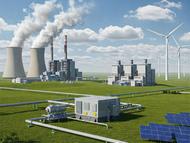Growing the Grid 2 - ORIGINAL CONTENT
- By:
- Edward A. Reid Jr.
- Posted On:
- Jun 16, 2025 at 6:00 AM
- Category
- Energy Policy, Climate Change
Increasing the capacity of the electric utility grid requires both expansion of electricity transmission and the expansion of natural gas production and pipeline transmission capacity.
Increasing electric transmission capacity to support coal, natural gas and nuclear generators would be relatively straightforward compared with increasing capacity to support wind and solar generation and storage. The conventional generators would require a smaller number of sites and could be located adjacent to existing transmission corridors, whereas renewable generation installations are generally lower generating capacity facilities, frequently located in remote areas some distance from existing transmission corridors and requiring construction of new transmission facilities in new rights of way.
The capacity of conductors in existing transmission corridors would have to be increased to accommodate the output of the additional generators, but approvals for such capacity expansion would be expected to be less difficult and more rapid than approvals for new transmission corridors. The incremental investment would also be far lower than for new transmission corridors. The incremental transmission investment required to connect renewable generation facilities could also be reduced by the impact of grid-scale storage at the renewable generation sites.
The situation for natural gas transmission is similar. The natural gas transmission and storage system is designed to meet current customer demands. Many existing natural gas generators rely on curtailable or interruptible transmission service and on spot market gas availability to reduce costs. However, during periods of peak demand, transmission service to these customers is frequently curtailed and spot market gas is unavailable or in very short supply. This situation significantly affects electric utilities ability to meet peak demand.
Data centers and AI facilities would require firm transmission service and firm gas supply contracts. However, this should not be a significant issue for them, since their demand is relatively consistent throughout the year, reducing cost per unit delivered. However, satisfying their demand would require pipeline capacity expansion, though much of that expansion could likely be accomplished by installing parallel pipelines in existing pipeline rights-of-way and/or adding compression and storage. The additional capacity requirements of other additional natural gas generation facilities could be included in the pipeline and storage expansions.
The extent of the generation and transmission expansion would be reduced, at least in the short term, by the termination of the federal “all-electric everything” focus, which would have required a rough tripling of generation, transmission and distribution capacity to replace the energy currently supplied by natural gas, propane and fuel oil in the residential, commercial and industrial markets.
Again, Congress could improve the investment environment by clarifying the intent of the Clean Air Act regarding CO2 emissions. The investments required to support data center and AI energy requirements are very large and would typically be subject to 40-year straight line depreciation. It would be essential that the investors be able to rely on fully depreciating their investments over their useful lives. A consistent policy and regulatory environment would reduce the costs and risks associated with the required investments and consequently the consumer costs.


